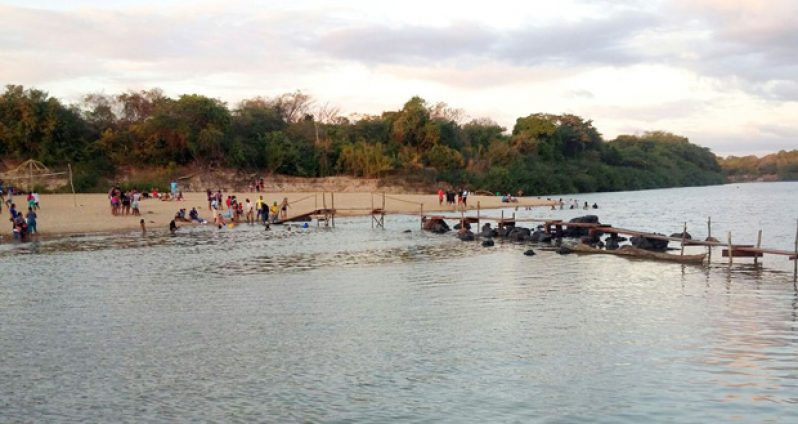– Rupununi drought continues
– Cash crop, livestock farmers count their losses
By Alva Solomon
REGION Nine is bracing for another month of dry weather conditions. Already, salty water is being pulled from some wells in the Rupununi.

Communities in the Central and South Rupununi have faced the brunt of the dry weather. At the moment, several wells which are important sources of water for most communities in the region have dried up, and residents in some communities have discontinued using others, citing the high level of salt concentration in the water.
Residents say that between 60% and 80% of the region is affected by the current drought conditions. Weather conditions are not expected to change anytime soon, with just a few days of rainfall forecasted in the weeks ahead.
Climatic data posted online at the World-Climates.com website have given a breakdown of the decline in rainfall in recent months in the Rupununi. The data indicates that the weather conditions started to change in mid-2015.
Regional Executive Officer (REO) Carl Parker told the Guyana Chronicle yesterday that while the region has been experiencing intermittent rainfall over the past two weeks, it is not enough to bring the expected relief to affected areas. He said there are reports that the water tables in some areas have seen improvement in water levels, and that persons, including farmers, are optimistic about the rains changing the situation.

The Regional Chairman noted that an emergency response committee was formed to respond to any eventuality. He said Vice Chairman Carl Singh sits on the committee, which is answerable to the Civil Defence Commission (CDC).
Total rainfall at Lethem dropped significantly after the June-July period, when 10 to 11 inches of rain fell, with 19 and 18 rainy days recorded for each month respectively. The weather began to change significantly in August, when there were only 14 days of rain, with a total of 7 inches of rain. Thereafter, the figures dropped to 7 days (September), 4 days (October), and 3 days (November) of rainfalls for the months at year-end.
For the month of September, there has been 3.6 inches of rainfall, followed by 0.9 inches (October) and 1.2 inches (November).
Last month, there were a mere four days of rain, with only 1.0 inches of rainfall, and the situation continues to appear grim.
Persons on the ground told this newspaper that the levels of the main waterways in the region have dropped significantly. A resident said that, apart from the devastating impact on crops, animals such as cows and horses are being taken to the rivers and creeks for water, but if the current conditions persist, the owners will have to consider searching for alternative water sources.
At the moment, residents can walk across the St Ignatius Creek on makeshift bridges, while the level of the Takutu River has dropped significantly in certain parts, and the situation is such that persons can also walk across the national water boundary.
One resident sent pictures of a well at St Ignatius, located less than 100 metres away from the Takutu River. The well, stretching to 33 feet in depth, is almost dry.
South of Lethem, several villages are also feeling the effects of the weather phenomenon. Dry weather conditions have been reported at villages along the Essequibo River south of Lethem, including at Sand Creek.
Pictures posted online by a recent traveller gave an illustration of the conditions, with the columns and foundation of an unfinished bridge which was built across the waterway clearly visible.
From Aishalton , former Toshao Tony James told the Guyana Chronicle yesterday that residents there have been sharing wells as the source of water has been drying up in certain parts of the community.
“The weather (has) had a terrible impact on drinking water especially”, James said. He noted, however, that there have been instances of light rainfall in the past week, and residents are hoping the trend improves.
He said there is a pipe in the community which runs from a drilled well and this has been a key source of water for some families in recent weeks. However, he said, its capacity cannot fulfill the needs of most households. The community also has another older well, but he was unsure of its serviceability.
“I see the necessity for drilled wells”, James said. He said there is water in the creeks nearby, but the levels have been dropping. Most residents take their cattle to those waterways.
Regional Chairman Bryan Allicock had told the Guyana Chronicle in October that several measures were being put in place to cope with the weather phenomenon. He had said that several standpipes were erected at villages which were severely affected by the conditions. He had explained that with the installation of the standpipes, water can be sourced from the drilled wells.
He had also noted that while the water levels in the wells may drop, they will not dry out completely.
There are 55 wells across Region 9, with more than 90% being photovoltaic (PV) system wells, while the remaining 10% includes hand-dug windmill wells and hand-dug shallow wells with Mark 11 hand pumps.
The Government Information Agency (GINA) has reported there is a 55% chance that El Nino conditions will continue into the second quarter of this year. This prediction has been based on the El Niño/Southern Oscillation (ENSO) diagnostic discussion issued by the Climate Prediction Center (NCEP) and the International Research Institute for Climate and Society in September.
As a result of the expected conditions, the Hydrometeorological Service has advised that appropriate water management practices be employed in the various sectors, and that households take action to militate against the forecasted drop in rainfall quantities.



.jpg)








